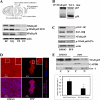Insulin-like growth factor receptor-1 and nuclear factor κB are crucial survival signals that regulate caspase-3-mediated lens epithelial cell differentiation initiation
- PMID: 22275359
- PMCID: PMC3381865
- DOI: 10.1074/jbc.M112.341586
Insulin-like growth factor receptor-1 and nuclear factor κB are crucial survival signals that regulate caspase-3-mediated lens epithelial cell differentiation initiation
Abstract
It is now known that the function of the caspase family of proteases is not restricted to effectors of programmed cell death. For example, there is a significant non-apoptotic role for caspase-3 in cell differentiation. Our own studies in the developing lens show that caspase-3 is activated downstream of the canonical mitochondrial death pathway to act as a molecular switch in signaling lens cell differentiation. Importantly, for this function, caspase-3 is activated at levels far below those that induce apoptosis. We now have provided evidence that regulation of caspase-3 for its role in differentiation induction is dependent on the insulin-like growth factor-1 receptor (IGF-1R) survival-signaling pathway. IGF-1R executed this regulation of caspase-3 by controlling the expression of molecules in the Bcl-2 and inhibitor of apoptosis protein (IAP) families. This effect of IGF-1R was mediated through NFκB, demonstrated here to function as a crucial downstream effector of IGF-1R. Inhibition of expression or activation of NFκB blocked expression of survival proteins in the Bcl-2 and IAP families and removed controls on the activation state of caspase-3. The high level of caspase-3 activation that resulted from inhibiting this IGF-1R/NFκB signaling pathway redirected cell fate from differentiation toward apoptosis. These results provided the first evidence that the IGF-1R/NFκB cell survival signal is a crucial regulator of the level of caspase-3 activation for its non-apoptotic function in signaling cell differentiation.
Figures






Similar articles
-
α6 integrin transactivates insulin-like growth factor receptor-1 (IGF-1R) to regulate caspase-3-mediated lens epithelial cell differentiation initiation.J Biol Chem. 2014 Feb 14;289(7):3842-55. doi: 10.1074/jbc.M113.515254. Epub 2013 Dec 31. J Biol Chem. 2014. PMID: 24381169 Free PMC article.
-
The canonical intrinsic mitochondrial death pathway has a non-apoptotic role in signaling lens cell differentiation.J Biol Chem. 2005 Jun 10;280(23):22135-45. doi: 10.1074/jbc.M414270200. Epub 2005 Apr 12. J Biol Chem. 2005. PMID: 15826955
-
Phosphatidylinositol 3-kinase (PI-3K)/Akt but not PI-3K/p70 S6 kinase signaling mediates IGF-1-promoted lens epithelial cell survival.Invest Ophthalmol Vis Sci. 2004 Oct;45(10):3577-88. doi: 10.1167/iovs.04-0279. Invest Ophthalmol Vis Sci. 2004. PMID: 15452065
-
Signaling of cell death and cell survival following focal cerebral ischemia: life and death struggle in the penumbra.J Neuropathol Exp Neurol. 2003 Apr;62(4):329-39. doi: 10.1093/jnen/62.4.329. J Neuropathol Exp Neurol. 2003. PMID: 12722825 Review.
-
Crossing paths: interactions between the cell death machinery and growth factor survival signals.Cell Mol Life Sci. 2010 May;67(10):1619-30. doi: 10.1007/s00018-010-0288-8. Epub 2010 Feb 16. Cell Mol Life Sci. 2010. PMID: 20157838 Free PMC article. Review.
Cited by
-
Suppression of MAPK/JNK-MTORC1 signaling leads to premature loss of organelles and nuclei by autophagy during terminal differentiation of lens fiber cells.Autophagy. 2014 Jul;10(7):1193-211. doi: 10.4161/auto.28768. Epub 2014 May 9. Autophagy. 2014. PMID: 24813396 Free PMC article.
-
The signaling landscape of insulin-like growth factor 1.J Biol Chem. 2025 Jan;301(1):108047. doi: 10.1016/j.jbc.2024.108047. Epub 2024 Dec 3. J Biol Chem. 2025. PMID: 39638246 Free PMC article. Review.
-
Suppression of PI3K signaling is linked to autophagy activation and the spatiotemporal induction of the lens organelle free zone.Exp Cell Res. 2022 Mar 15;412(2):113043. doi: 10.1016/j.yexcr.2022.113043. Epub 2022 Jan 29. Exp Cell Res. 2022. PMID: 35101390 Free PMC article.
-
Regulatory effect of Bcl-2 in ultraviolet radiation-induced apoptosis of the mouse crystalline lens.Exp Ther Med. 2016 Mar;11(3):973-977. doi: 10.3892/etm.2015.2960. Epub 2015 Dec 29. Exp Ther Med. 2016. PMID: 26998022 Free PMC article.
-
Functional integration of eye tissues and refractive eye development: Mechanisms and pathways.Exp Eye Res. 2021 Aug;209:108693. doi: 10.1016/j.exer.2021.108693. Epub 2021 Jul 3. Exp Eye Res. 2021. PMID: 34228967 Free PMC article. Review.
References
-
- Maelfait J., Beyaert R. (2008) Non-apoptotic functions of caspase-8. Biochem. Pharmacol. 76, 1365–1373 - PubMed
-
- Schwerk C., Schulze-Osthoff K. (2003) Non-apoptotic functions of caspases in cellular proliferation and differentiation. Biochem. Pharmacol. 66, 1453–1458 - PubMed
-
- Weber G. F., Menko A. S. (2005) The canonical intrinsic mitochondrial death pathway has a non-apoptotic role in signaling lens cell differentiation. J. Biol. Chem. 280, 22135–22145 - PubMed
Publication types
MeSH terms
Substances
Grants and funding
LinkOut - more resources
Full Text Sources
Research Materials

